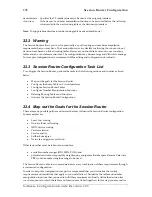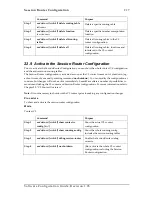
Session Router Configuration
211
Command
Purpose
Step 1
node
(ctx-cs)[
switch
]#called-party
tbl-name
key
dest-interface
if-name
or
node
(ctx-cs)[
switch
]#called-party
tbl-name
key
dest-table
tbl-name
Create a CdPN routing table
tbl-name
for destination interface
if-name
or
destination table
tbl-name
by entering
the first line.
Step 2
Repeat step 1 to add lines for
additional table entries.
Example: Called Party Number Routing Table
SN(cfg)#
context cs
SN(ctx-cs)[switch]#
called-party national 001 dest-interface USVoIP-A
SN(ctx-cs)[switch]#
called-party national 001320 dest-interface
USVoIP-B
SN(ctx-cs)[switch]#
called-party national 0044 dest-interface EuroVoIP
SN(ctx-cs)[switch]#
called-party national 0049 dest-interface EuroVoIP
SN(ctx-cs)[switch]#
called-party national default dest-interface
DefAcc
22.6.4 Create a Calling Party Number Routing Table
The Calling Party Number (CnPN) table is used to route calls based on the CnPN in the call set-up
message. This number in general corresponds to the extension number of a PBX or MSN of an ISDN
terminal. The table can be used to route calls from extensions, which have particular call routing
requirements (i.e. Terminals which require non VoIP capable ISDN services). The Session Router
looks for the longest match starting with the
last
digit of the calling party number.
Note:
The calling party number is sometimes inserted or modified by a PBX.
Procedure
To create a CnPN routing table
Mode
Context CS
Command
Purpose
Step 1
node
(ctx-cs)[
switch
]#calling-party
tbl-name
key
dest-interface
if-name
or
node
(ctx-cs)[
switch
]#calling-party
tbl-name
key
dest-table
tbl-name
Create a CnPN routing table
tbl-name
with key
key
for destination interface
if-
name
or destination table
tbl-name
by
adding the first line.
Step 2
Repeat step 1 to add lines for multiple
table entries.
Example: Calling Party Number Routing Table
Software Configuration Guide, Revision 1.03






























